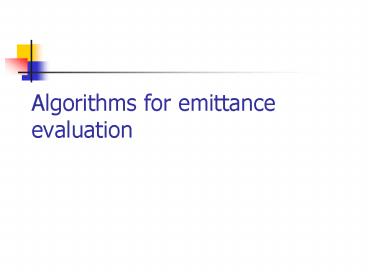Algorithms for emittance evaluation PowerPoint PPT Presentation
1 / 49
Title: Algorithms for emittance evaluation
1
Algorithms for emittance evaluation
2
Emittance measurements
3
Slit-grid devices
- Trusted method
- Wire current resolution 1pA
- Integration time 1us..Nsec
- Spatial resolution 100um
- Measurement time minutes
4
Slit-grid control software
5
Pepper-pot measurements without scintillating
screen
6
Use of optical registration
7
An example of optimal resolution ratio for single
shot operation
8
Dedicated algorithms and outputs
9
Scattering effects in screens, holes and slits
10
Pepper-pot calibration
- Pinhole effective radius calibration
- Estimation of the light scattering effect in the
screen - Pinholes zero position calibration with
low-emittance light beam
11
Use of multiple profile monitors
12
Use of variable quadrupole strengths
13
Longitudinal emittance measurements
Timo Milosic. Thursday. 1050
14
Ellipses and linear optics
15
(No Transcript)
16
Canonical distributions
17
Universal algorithms
- Mostly exist for two-dimensional phase space
- Applicable for any measurement type
- Data transformation applying of linear optics
element, resampling etc. - Noise and fraction reduction
- Data healing tools
- 2-D emittance calculation
18
Use of KV-plane for the emittance estimation
19
Use of statistical momentums
20
Use of optimal fitting methods
21
Use of parametric data fit
22
A comparison of different methods
23
Errors estimation
- Noise added to the data value
- Errors due to the model simplification
- Limitation of the parameterized model
- Limited accuracy of parameters of involved beam
optics elements - Non-ideal registration equipment (non-linearity,
aberrations, cross talk, )
24
Typical output of the emittance evaluation results
25
Typical preliminary data evaluation in 2-D space
26
An example of an interactive tool for 2-D
emittance evaluation
27
Few nice output plots which good to have for
report and publications
- For standalone applications OpenGL primitives
library - To save some time one may use TeeChart
- Tools based on MATLAB or MathCAD could be easily
adapted to any new ideas. License cost is
critical.
28
Typical preliminary data evaluatin in 2-D space
29
A data manipulation possibilities are always
demanded
30
The basic evaluation uses only first order
integration algorithms
Main calculations in EmitView are executed on the
data matrix. Each element of this matrix owned an
elementary current. In the assumption that the
current density is uniformly distributed on the
surface of elementary cell, this current is equal
to product Ii,kJi,kdxdy. Where J is the
current density in the phase space
coordinates. Thresholds and KV levels are
defined as a percentage of the maximum elementary
current value. Captured current and KV plane are
defined as a part of full current, which is sum
of all elementary currents. RMS emittance for
defined KV level is calculated by
formula . Statistical parameters for given
formula are calculated for current density
weighted elementary cells. Only cells with
current higher then KV level are taking into
account.
31
Pepper pot algorithms
- Image processing technique
- Limited spatial resolution
- 4- dimensional phase space
32
Pepper-pot classical data preparation
EMITTANCE MEASUREMENTS AT THE NEW UNILAC
PRE-STRIPPER USING A PEPPER-POT WITH A
PC-CONTROLLED CCD-CAMERA. M.Dolinska et al. DIPAC
1999, Chester. UK.
33
Noise cancellation
34
Local spot filtering
35
Parametric nonlinear data fitting
36
Image evaluation cycle
37
Horizontal profile
38
(No Transcript)
39
(No Transcript)
40
(No Transcript)
41
(No Transcript)
42
(No Transcript)
43
(No Transcript)
44
(No Transcript)
45
An example of a heavy ion beam investigation
Beam divergence as a function of applied
potential
7kV
10kV
14kV
46
An example of a heavy ion beam investigation(2)
47
An example of a heavy ion beam investigation(3)
48
An example of a heavy ion beam investigation(4)
49
Parametric nonlinear data fitting

